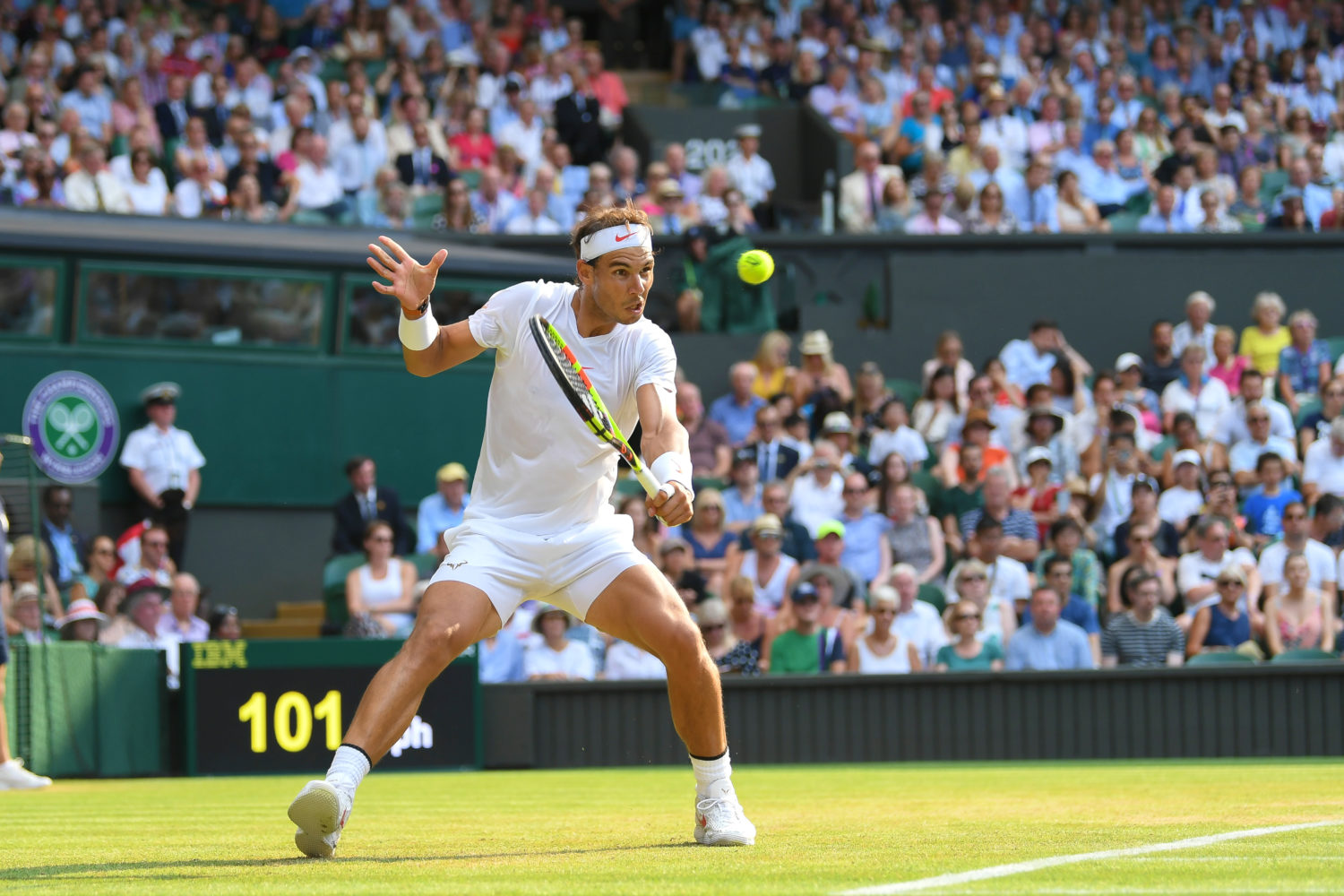Changing the Game

When in 1875 Pierre Babolat founded a company producing racquet strings from sheep intestines, he could have scarcely envisioned the racquet sports dynasty he was about to build and the impact it would have on the world of tennis.
Tennis, as we know it today, took on its current shape not much earlier, and in many ways, Babolat evolved together with the sport – at times directly advancing it with technology and ingenuity.
Pierre Babolat was an expert in processing natural gut for surgical thread, musical instruments, and archery before deciding to adapt them for early tennis racquets. Through its small beginnings, Babolat became the first company to focus on racquet games. Over the years, it expanded into the production of racquet frames, clothes, footwear, stringing machines, tennis balls, grips, wrist-worn play tracking devices, and a variety of tennis accessories.
In 1925, Pierre Babolat Senior’s son, Albert, already in charge of the family business, introduced a new type of string. As the story goes, a group of French tennis players called The Musketeers – Jean Borotra, Jacques Brugnon, Henri Cochet, and René Lacoste – were sent samples of alphabetically labelled strings for testing. They settled on the one marked with a V, and thus Babolat VS was created. To date, over 100 racquets fitted with the VS string struck the winning championship shot at a Grand Slam tournament.
About the same time that Pierre Babolat sat in his Lyon apartment, not realising he was about to change the landscape of tennis forever, a group of people across La Manche was doing the same thing.
The All England Lawn Tennis and Croquet Club, as the Wimbledon club was known before it adopted its present name, is a private club founded in 1868 in Southwest London, originally for croquet only. Nine years later, in 1877, as tennis grew in popularity and croquet began to fade into the side-lined sport for enthusiasts it is now, the club decided to hold its first tennis tournament in order to pay for the repairs of the pony roller used to maintain the lawn.
Contested on grass courts by 22 players, who each paid one guinea to enter the event – about £1.05 in today’s money – and after paying out 12 guineas to the winner as the prize money, the tournament booked a profit of £10 and was able to afford the repairs. 144 years later, The Championships, as Wimbledon is known today, has grown in size and stature.
Each year, over 700 players in singles and doubles brackets enter the tournament through the main draw and qualifying round, with juniors, seniors, and exhibition matches on top of that, to compete for a slice of the £34,000,000 in prize money.
While not even the eldest tennis fans remember the first player to appear at Wimbledon with the racquet strings produced by the French company, over the next century, Babolat had a hand in some of Wimbledon’s most memorable moments.
In the summer of 1976, Björn Borg became Wimbledon’s youngest male champion after blazing through the tournament without dropping a set. Borg, playing with a racquet fitted with the VS string, was the first man to do so. Three decades later, on the same hallowed turf, Rafael Nadal dropped his Babolat Pure Aero racquet to the ground in ecstasy as he snapped Roger Federer’s five-time Wimbledon-winning streak.
Under the leadership of Pierre Babolat and his descendants, the French company expanded its range of products from strings to tennis equipment and, in 1994, tennis racquets.
Breaking into a new market, with such established competitors as Head and Wilson, was not easy but Babolat’s lucky star – or if you are the more down-to-earth type, their scouting acumen – twinkled. At the 1998 French Open, Carlos Moyá, a 22-year-old Spaniard with the flowing hair of a matador, wielding a blue Pure Drive, became the first player using a Babolat racquet to win a Grand Slam tournament.
Two of the junior winners at the same tournament, Kim Clijsters, and Fernando González, were also using Babolat gear. Less than a year later, Moyá was ranked number one in the world while Clijsters and González were on the fast track to the tennis elite.
Today, after almost three decades, Babolat’s revenues have more than tripled and their forage into the racquet industry is widely considered a masterstroke.
In July 2017, Garbiñe Muguruza, continuing the lineage of Pure Drive-using champions started by Carlos Moyá, twirled around the centre court trying to hold back tears of happiness. After the 2015 heartbreak, when she lost in the final to Serena Williams, she was finally a Wimbledon champion.
Two months later, in September 2017, Babolat marked a special occasion – the Spanish superstars, Muguruza and Nadal, were ranked number one in the world at the same time.
It doesn’t take more than a stroll through any tennis shop to realise how far the Babolat brand has come since its inception as a string maker. From racquet frames to strings to tennis bags to clothing – today it is perfectly possible for a player to dress fully in Babolat gear, from head to toe, and compete at the highest level.
In fact, the three-time Wimbledon finalist, Andy Roddick (he lost all three finals to Mr Wimbledon himself, Roger Federer) did just that for a time. The big-serving American travelled the tour with his customised Pure Drive Roddick GT racquet, fitted with Babolat RPM Blast racquet strings, and wearing Babolat Propulse III tennis shoes. Although he never won Wimbledon, he did lift the US Open trophy, among 31 other tournaments, and reached world number one in 2003, so there is something to be said about the French brand’s ability to support champions.

The company, with its family values, has long cultivated a close relationship with its athletes – every sponsored player is invited to the French company’s headquarters and given a tour. Their racquets, the most important tool in any competitor’s arsenal, are given special consideration and, over a process that often takes months of back-and-forth feedback and consultations, are customised to suit every single requirement.
When a single point can spell the difference between triumph and disaster, between lifting that long-coveted trophy and going home with a runner’s up plate, the players cling on to the tiniest advantage they can.
When Rafael Nadal needed adjustments made to his weapon of choice, Babolat worked tirelessly on the Pure Aero creating a number of iterations – each varying in weight and its distribution, the thickness of the beam, and other minute details – and delivered them for testing.
Another of the important steps in the company’s voyage into the tennis world came in 2003 when the French brand partnered up with Michelin. The years of expertise possessed by the mobility giant, combined with Babolat’s knowledge of the tennis world, resulted in the production of footwear aimed at both enthusiasts and professionals alike.
Babolat themselves believe that there is no such thing as a perfect shoe as each player looks for a different fit and feel.
However, innovation, expertise, and product quality are all part of Babolat’s culture, and their line of shoes – built using different technologies and tailored to different needs – includes a range of options to suit the most demanding of individuals.
A typical Babolat shoe is divided into two distinct parts – the upper textile fabric and the outsole made from rubber.
Babolat engineers created the upper part in partnership with Chamatex, a French textile maker. The two companies have worked together since 2013 inventing a new technical textile called Matryx.
The goal, which Babolat and Chamatex engineers have accomplished, was to create an upper part of the shoe that weighs less than 100 grams.
The outsole part of the shoe was built in cooperation with Michelin. Just as Michelin develops their tyres to suit diverse conditions – whether it’s a rally, racing, or the street – they have taken that approach to understand and develop outsoles for the Babolat footwear for different surfaces of the tennis court.
One of the defining features of the tennis calendar is the variety of surfaces the players compete on throughout the year. The tour kicks off in January in the Southern hemisphere on Australian hard courts and moves north.
As the seasons shift over time, so do the surfaces of the courts – from late March to early June tennis is dressed in red and the players compete mostly on clay. After that, they switch to grass until the end of July, when they go back to hard courts.
Each of the different surfaces puts a different kind of strain on the player’s body and thus requires a different kind of footwear.
Tennis movement is all about bursts of sprinting and rapid changes of direction – players rarely take more than ten steps before it’s time to slam on the breaks and explode in a different direction. For that, traction is key, which is considerably easier to achieve on hard courts than it is on clay or grass.
Another defining characteristic of Wimbledon that needed to be considered during the creation of the footwear for grass was the all-white dress code of the tournament.
The result is striking – Babolat grass court shoes combine a durable but flexible upper part, in an all-white aesthetic, with an outsole designed to support the intricacies of playing on the grass.
In September 2013, the bond shared by Babolat and Wimbledon tightened even further as the organisers announced that all the tournament’s ball boys and ball girls would be wearing Babolat footwear. These days, the sight of the pristinely white Babolat shoes darting around the Wimbledon courts from one stray ball to another, like some giant game of Snake, is as iconic as the snazzy Ralph Lauren polos that accompany them.
Today, Babolat is a multimillion-dollar company permanently embedded into the fabric of the sport. Stroll up to any tennis court in the world – a professional tournament, a club level match, a casual knockabout in the park – and the chances are you will stumble across someone playing with a Babolat racquet, a racquet fitted with Babolat strings, or wearing a pair of Babolat shoes.
Despite expanding dramatically – Babolat employs over 350 people and books revenues far north of €100m a year – the company has managed to stay grounded and preserve its family ethos. In fact, it still maintains the original premises.
In keeping up with the Babolats – from Pierre to Albert to Paul to Pierre – the family name has always featured on the company papers, difficult as it was at times. The current president, Eric, was thrust into the top position at the age of 28 when his father, Pierre, died in a plane crash.
When asked, Eric Babolat remarked that although he didn’t feel ready to take the helm, he didn’t hesitate either. “I wanted to continue the story,” he said.
Story published in Courts no. 1, summer 2021.